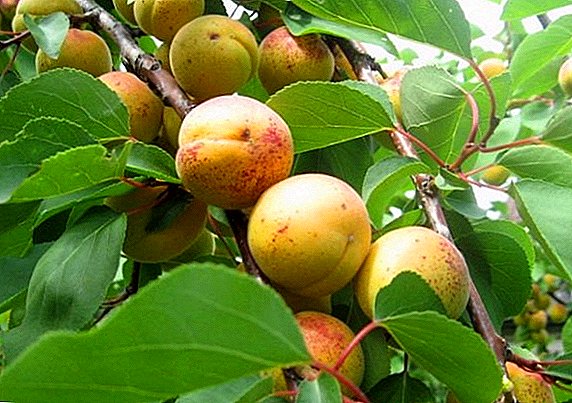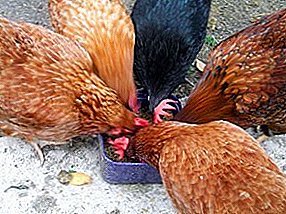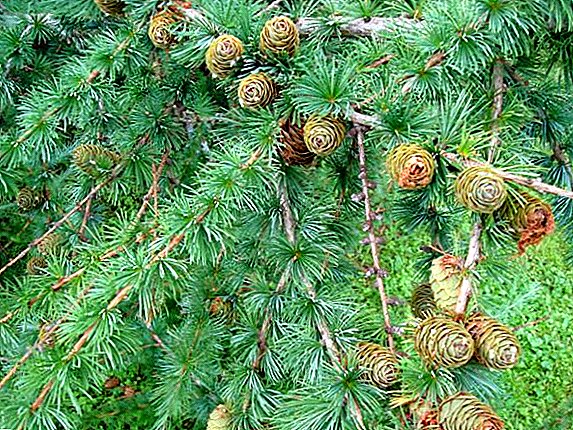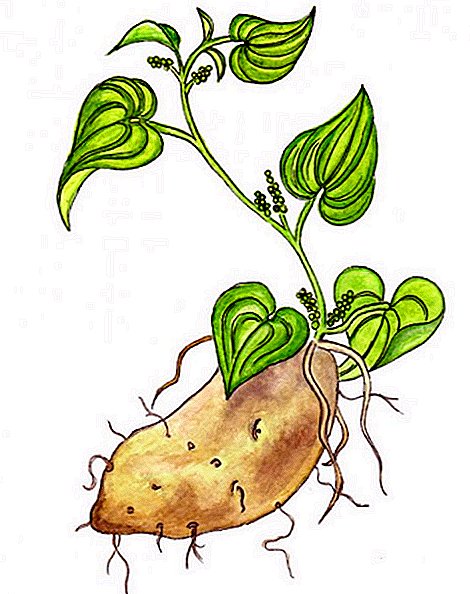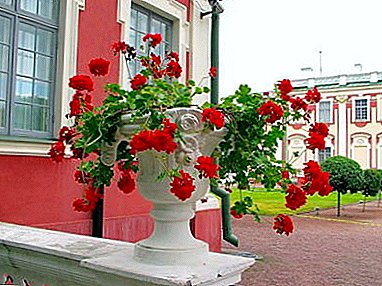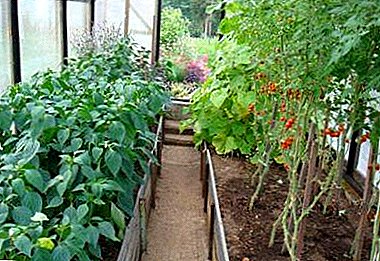
Greenhouse designs allowed growers to produce year-round yields. But for success, it is not enough just to build a high-quality structure; it is very important to know the parameters of the neighboring cultures when growing.
Can I plant tomatoes with pepper, and when is it better to do it? This and much more you will learn from our article.
We give detailed instructions on the joint planting of tomatoes and peppers and care for them in greenhouse conditions.
Is it possible to plant these vegetables together?
How recommended is this?
reference. Tomatoes and peppers get along together quite well, as both belong to the family of the nightshade. Therefore, we can definitely recommend their joint cultivation in the greenhouse.
One has only to make a little effort to provide conditions that are simultaneously suitable for the healthy development of both plants.
Advantages and disadvantages
pros:
 Tomatoes produce special essential oils that are intolerable to aphids, which has a beneficial effect on the peppers subjected to its attacks.
Tomatoes produce special essential oils that are intolerable to aphids, which has a beneficial effect on the peppers subjected to its attacks.- The sizes of crops allow to combine both types on one bed, which significantly saves space.
Minuses:
- Together with tomatoes, only sweet varieties of pepper can be planted. Bitter, when pollinated, will negatively affect the taste of tomatoes.
- Pepper likes moist soil, for a tomato it is destructive. Therefore, it will be necessary to constantly maintain a delicate balance of moisture saturation of the soil in order to provide comfort to both cultures.
Preparatory activities
What should be the place for landing?
Modern greenhouse can be constructed from glass and film or from polycarbonate. The main condition is that it should be of sufficient height for the full development of tomatoes. The greenhouse must be equipped with the correct lighting and uninterruptedly functioning ventilation system.
Special varieties for co-cultivation
If the greenhouse is small and you need to save space, you should buy tall varieties of tomatoes and short peppers, so that you can plant them on the same bed. The following varieties of peppers are a great option.:
- Eroshka;
- Apricot favorite;
- Isabel;
- Swallow;
- Chanterelle;
- Albatross;
- Fakir;
- Timoshka.
For joint cultivation with peppers varieties of tomatoes are well suited:
- Aksinya;
- Eupator;
- Zhenaros;
- Pablo;
- Typhoon.
Priming
 The soil for the cultivation of tomatoes and peppers can be purchased at specialty stores and put it in a greenhouse. You can also prepare the substrate yourself. The soil should contain a large amount of peat, as it is able to keep warm, it is very important for the comfortable existence of both cultures.
The soil for the cultivation of tomatoes and peppers can be purchased at specialty stores and put it in a greenhouse. You can also prepare the substrate yourself. The soil should contain a large amount of peat, as it is able to keep warm, it is very important for the comfortable existence of both cultures.
The soil should be loose and slightly moist and basically consist of clay or loamy soil with the addition of sawdust, humus and the aforementioned peat in equal proportions. The greenhouse is completed at the rate of 3 buckets of the substrate per square meter. m
How to grow?
It is necessary to plant crops in a checkerboard pattern., placing in the first stage in the ground tall varieties of tomatoes, keeping the distance between the bushes 40 cm, and after planting between them bushes of pepper. This arrangement of seedlings in three rows is suitable for a greenhouse size 6x3. It allows not to deprive any plant of lighting, since after cutting the lower stepsons for pepper a lot of free space will open.
You can also plant bushes of peppers along the tomato rows, while keeping the distance between crops at least 20 cm. The next landing option involves the arrangement of tomatoes and peppers on opposite sides of the greenhouse: with one tall variety of tomatoes, with the other arrange a hotbed for peppers.
Important! It is desirable to have the beds in the direction from north to south, at a distance of at least 70 cm from each other, they must be at least 20 cm high and 60-90 cm wide.
Seeds
Tomato
- Boxes for sowing, about 8 cm high, are placed in a greenhouse, where room temperature must be maintained and good lighting must be arranged.
- The soil is poured into them, lightly tamped down and grooves are made, 1 - 1.5 cm deep.
- In the grooves lay the seeds, pre-aged for three hours in a weak solution of potassium permanganate.
- Spill water.
- After the shoots appear, in a week the seedlings dive. This should be done at the stage of two formed leaflets.
- Moving to a more spacious container should be carried out for each sprout separately, while maintaining the earthy lump on the spine.
Pepper
- Seeds are disinfected, wrapped in a gauze bag and immersed first in warm boiled water for 2 hours, then for 25 minutes in a solution of potassium permanganate. After rinsed with running water and dried.
- Seeds are placed in boxes for seedlings with pre-prepared soil, deepening an inch.
- Temperature and light conditions for germination are similar to those for tomatoes.
- After the emergence of seedlings saplings dive.
Seedlings
- It is necessary to plant seedlings in the greenhouse, being sure that the heat-loving crops will not be exposed to low temperatures.
- The best time is the end of April - the beginning of May.
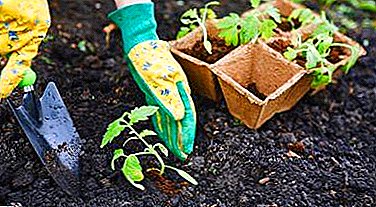 You also need to focus on the development of seedlings, its leaves should be well formed, and the height should be at least 30 cm.
You also need to focus on the development of seedlings, its leaves should be well formed, and the height should be at least 30 cm.- The wells for planting should be 20 cm deep, they should be shed with a weak solution of potassium permanganate per 1 l per well.
- Seedlings need to carefully remove from the containers without damaging the earthy room.
- Immerse in the wells.
- Sprinkle with soil and lightly tamp.
- Water under the root of each plant with warm water.
Care instructions
Despite the fact that these vegetables belong to the same family, their care is not identical.
Watering and fertilizer
Agro-technology of tomatoes requires low humidity, maximum 60% in terms of hygrometer. The plant does not tolerate overflows and moisture on the foliage. Pepper can bear fruit both at low and high levels of humidity. Allowed frequent watering and the plant is not afraid of moisture on the leaves.
Top dressing for the first time make two weeks after the planting of vegetable crops. Fertilize plants with a mixture of mullein and nitrophoska, in the ratio of 1 tbsp of nitrophoska, 0.5 l of liquid mullein per 10 l of water. The mixture must be made under the bushes. After 10 days, another top dressing with potassium sulfate is carried out; it will need to be applied 3 times throughout the season.
Trimming, pinching, pinching
Paceynki - lateral unnecessary processes developing in the axils of the leaves, should be cut, as well as the lower leaves. Leaving on the main shoot no more than five brushes. One month before the end of the growing season, pinch the tip.
Props, hanging
Tall varieties of tomatoes require binding. To do this, stakes and tomato stems are tied with a string to the support at the edge of the garden. As the plant grows, the number of nodes will increase. Hanging is relevant if a non-standard vertical method is used for growing crops, for example, in bottles.
Diseases and pests
- Slugs and snails - Peppers - a favorite delicacy of these pests. To get rid of their invasion - you need to set a trap. Lay out the slate with small tunnels between the beds, in less than a day all the pests will be under the slate, after which they can be destroyed. The procedure must be repeated for several days.
- Late blight - A fungal disease of tomatoes that starts the processes of decay. Arises due to overflows. It is important to monitor soil moisture and in the case of an existing lesion in time to apply fungicidal agents.
- Brown tomato leaf spot - fungal disease, manifested in the form of dry brownish spots on the leaf plates of tomatoes. The fight against the disease is carried out with the help of fungicides.
- Pepper phytoplasmosis - the disease is caused by aphids and spider mites. Bush does not grow to the stated size, the leaves dry and curl, the plant is deformed. In the fight against the disease are effective insecticides.


 Tomatoes produce special essential oils that are intolerable to aphids, which has a beneficial effect on the peppers subjected to its attacks.
Tomatoes produce special essential oils that are intolerable to aphids, which has a beneficial effect on the peppers subjected to its attacks. You also need to focus on the development of seedlings, its leaves should be well formed, and the height should be at least 30 cm.
You also need to focus on the development of seedlings, its leaves should be well formed, and the height should be at least 30 cm.